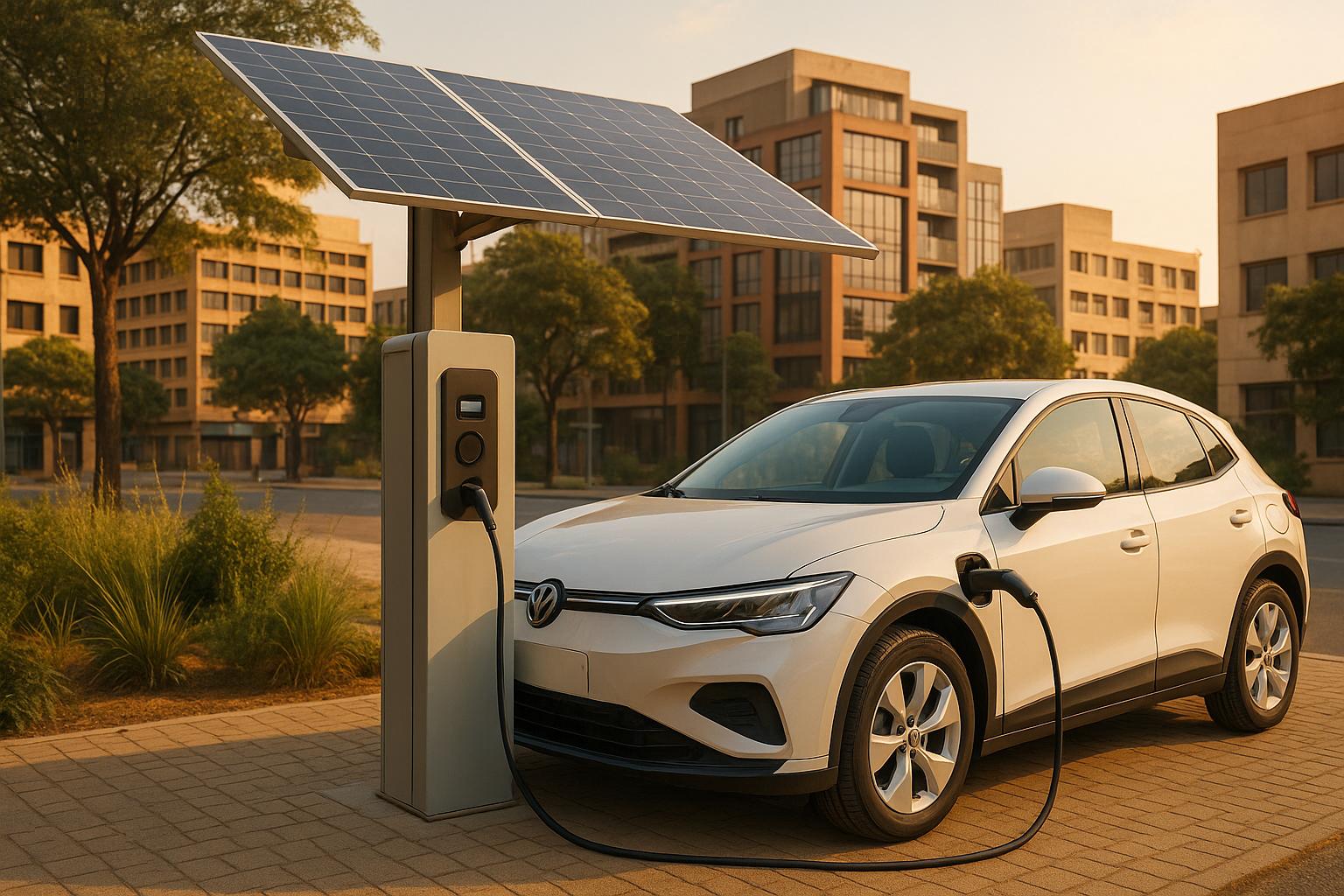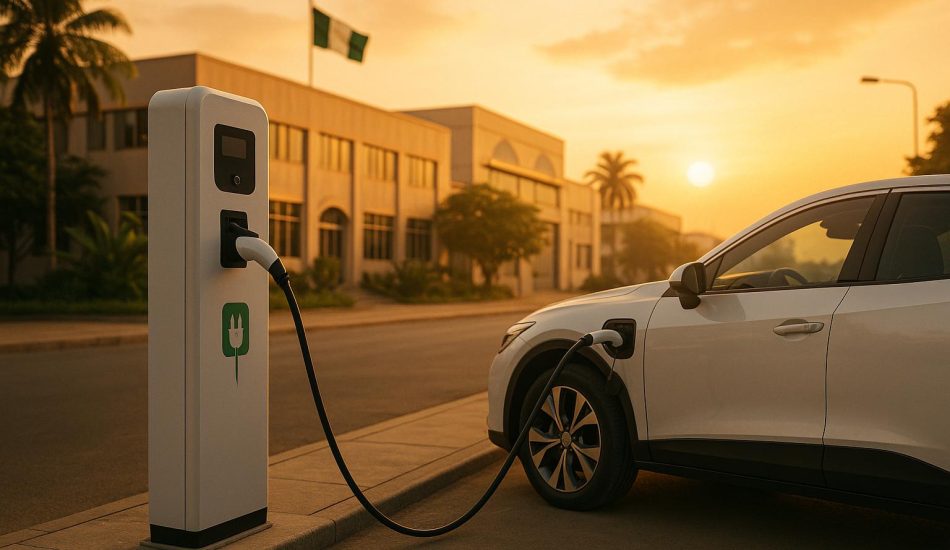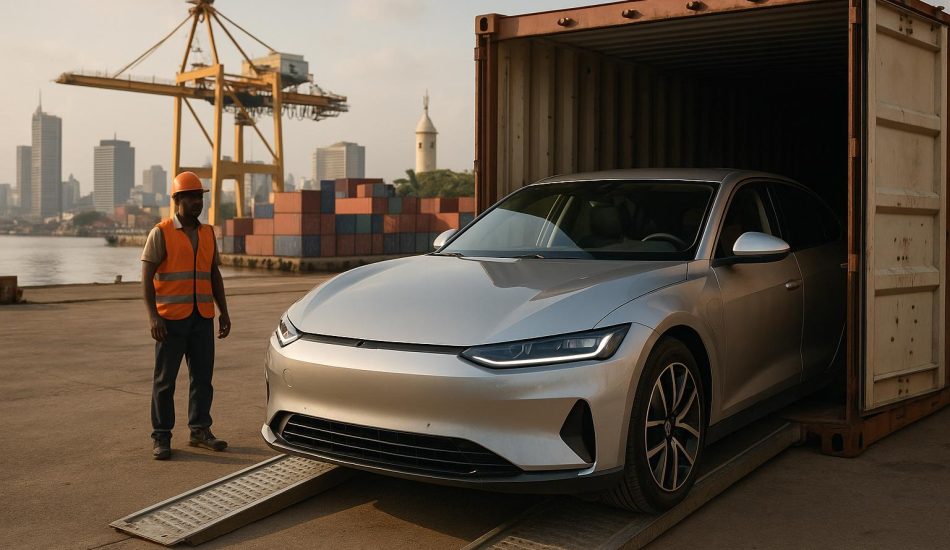
Africa’s electric vehicle (EV) market is growing, but adoption remains slow due to financial and infrastructure challenges. Here’s a quick look at the key drivers and obstacles:
Key Drivers:
- Government Incentives: Tax breaks and reduced import duties make EVs more affordable.
- Renewable Energy: Solar and wind power support EV charging networks.
- Consumer Demand: Urban buyers and businesses are prioritizing cleaner transportation.
Barriers:
- Limited Charging Infrastructure: Few public charging stations create range anxiety.
- High Costs: EVs remain expensive, with limited financing options.
- Import Dependency: Lack of local production raises prices and delays repairs.
Top Countries Leading EV Adoption:
- Ethiopia: Renewable energy focus and import rule changes.
- Kenya: Growing charging networks and public transport electrification.
- Rwanda: Investment in electric public transportation in Kigali.
What’s Next? Collaboration between governments, businesses, and communities is essential to improve financing, expand charging networks, and address cost barriers. The next few years will determine how quickly Africa can shift to cleaner transportation.
SA’s fully electric fleet to reach 22 500 cars by 2030 – report
What’s Driving EV Growth in Africa
Electric vehicles (EVs) are gaining traction in Africa, fueled by a mix of renewable energy availability and shifting consumer priorities. These factors are reshaping how people think about and approach transportation, creating opportunities for EVs to thrive. Let’s explore how government initiatives, renewable energy, and consumer trends are driving this change.
Government Support and Tax Incentives
Across Africa, governments are stepping up to make EVs more accessible. By revising import duties, offering tax breaks, and rolling out support programs, they’re helping to reduce the financial barriers to owning an electric vehicle. These policies not only reflect a growing commitment to greener transportation but also make EVs a more appealing choice for both individuals and businesses.
Renewable Energy Integration
Africa’s abundant sunshine and expanding renewable energy projects are key to supporting EV infrastructure. With high solar irradiance and growing investments in solar and wind power, the continent is well-positioned to develop EV charging networks that rely on clean energy. This synergy not only boosts the environmental advantages of EVs but also offers users a chance at more predictable energy costs.
Shifting Consumer Preferences
Consumers are also driving the push toward EVs. Urban dwellers, in particular, are drawn to the promise of cleaner air and the potential for long-term savings, even if the upfront costs are higher. Beyond individual buyers, businesses are increasingly factoring sustainability into their strategies, further encouraging the adoption of electric vehicles as part of a broader commitment to environmental responsibility.
Main Barriers Slowing EV Adoption
While the push for electric vehicles (EVs) in Africa is gaining momentum, several hurdles are slowing down the shift to cleaner transportation. These challenges impact both individual buyers and businesses, making the transition more complex.
Lack of Charging Stations
One of the biggest obstacles is the limited availability of charging infrastructure. Gas stations are easy to find in most areas, but public EV charging stations are still rare. This shortage fuels range anxiety – drivers worry about running out of power without a nearby place to recharge.
Efforts are underway to expand charging networks in urban areas, focusing on high-traffic spots. However, rural areas and smaller towns are often left behind. For many, the only viable option is to install home charging systems, which isn’t always practical or affordable.
The slow progress in building charging networks is tied to high installation costs and unreliable electricity grids in some regions. This creates a catch-22: potential EV buyers hesitate due to the lack of charging options, while investors are cautious about funding infrastructure until more people own EVs.
High Purchase Prices and Limited Financing
The price tag on EVs remains a major barrier for many African consumers. Even in global terms, EVs are costly, but in regions with lower average incomes, they can feel completely out of reach. Financing options are also limited, making it harder for buyers to spread the cost.
Banks often view EVs as a risky investment since the technology is still relatively new, and the resale market is uncertain. As a result, buyers may need to pay in cash or accept loans with less favorable terms. On top of that, insurance premiums for EVs tend to be higher, adding another layer of expense.
No Local Production and Import Dependencies
Africa’s reliance on imported EVs drives up costs even further. Shipping fees, tariffs, and supply chain delays all add to the final price, while global disruptions can make matters worse. The lack of local manufacturing also means spare parts, batteries, and charging equipment are harder to come by. When repairs are needed, delays in sourcing components can leave vehicles out of action for extended periods – a serious issue for businesses relying on fleets.
There are some promising efforts to kickstart local EV production, but these are still in their infancy. Building a robust EV manufacturing sector will require significant investment, a skilled workforce, and supportive policies. Until these gaps are addressed, the market will continue to face challenges in scaling up.
sbb-itb-99e19e3
Top African Countries for EV Adoption
Several African nations are stepping up with focused strategies to encourage the use of electric vehicles (EVs). Here’s a closer look at three countries making significant progress:
Ethiopia
Ethiopia is reshaping its import rules and rolling out incentives to encourage EV adoption. Tapping into its strong renewable energy resources, the country is working toward a more sustainable transportation system. While infrastructure hurdles remain, Ethiopia’s efforts signal a commitment to greener mobility.
Kenya
Kenya is making strides by expanding its network of charging stations and introducing policies to support electric mobility. The private sector is playing a big role, particularly in transitioning public transport to electric options. At the same time, improvements in grid reliability and renewable energy capacity are boosting Kenya’s ability to sustain this shift.
Rwanda
Rwanda is transforming its public transport system by integrating electric technologies. Kigali, the capital, is at the forefront, testing new infrastructure and financing models to make EVs more accessible. These efforts are part of Rwanda’s broader push to cut carbon emissions and create a cleaner, more efficient urban transport system.
Solutions to Speed Up EV Adoption
The growth of electric vehicles (EVs) in Africa faces challenges like high costs, limited financing, and a lack of charging stations. However, governments and businesses across the continent are stepping up with creative solutions to address these hurdles. These efforts aim to make EVs a practical and accessible option for everyday consumers.
New Financing Options
Traditional car loans often fall short of meeting the needs of many African consumers. To bridge this gap, new financing models are emerging that reduce upfront costs and align payment plans with local income levels.
- Pay-as-you-go models are gaining popularity, allowing buyers to pay in installments that fit their budgets.
- Leasing programs are also on the rise, especially for commercial vehicles. For example, MAX offers e-motorcycles priced around $2,000, with structured payment plans that include maintenance and insurance, making ownership more predictable and affordable.
Financial partnerships are also playing a critical role, creating tailored credit solutions that reflect local market conditions. These options not only help buyers access financing but also enable lenders to assess risks more effectively.
While financing solutions are key, they need to go hand-in-hand with improved charging infrastructure to ensure EVs are practical for daily use.
Building More Charging Networks
Expanding charging networks is essential to overcoming one of the biggest barriers to EV adoption: infrastructure gaps. Governments and private companies are joining forces through public-private partnerships, combining policy support with private sector efficiency to build these networks.
Innovative approaches like solar-powered charging stations and mobile charging solutions are being deployed to extend coverage. Solar-powered stations, in particular, help reduce dependence on unreliable electrical grids while lowering operational costs. For services like motorcycle taxis and delivery fleets, portable charging units and battery swapping stations add much-needed flexibility.
Urban areas are also seeing growth in workplace and residential charging programs. Employers are installing charging points as perks for their employees, and new housing developments are increasingly including EV charging facilities.
Public Education Programs
Education and awareness are critical to dispelling myths about EVs and encouraging adoption. Many consumers still have concerns about battery life, maintenance costs, and how EVs perform under local driving conditions.
- Awareness campaigns are tackling these misconceptions head-on.
- Demonstration programs let potential buyers test EVs, helping build confidence in their capabilities for both city and rural use.
Technical training initiatives are also equipping local mechanics with the skills to maintain EVs, ensuring long-term support for owners. Meanwhile, community outreach efforts focus on groups like taxi drivers, delivery companies, and government fleet operators, highlighting the economic advantages of EVs, such as lower fuel and maintenance costs.
Digital platforms are amplifying these efforts by sharing user stories, cost comparisons, and practical tips for EV ownership. To resonate with diverse audiences, these programs use local languages and involve trusted community leaders and experienced EV owners to address specific regional concerns.
What’s Next for EVs in Africa
Africa is at a pivotal moment in its journey toward adopting electric vehicles (EVs). The continent has several advantages that could support a successful shift – abundant renewable energy resources, shifting government policies, and a rising awareness among consumers about the advantages of electric transportation.
Governments across various nations are taking steps to build on this momentum. By introducing coordinated policy measures, they aim to reshape the transportation sector. However, for this transformation to be effective, there’s a need for flexible financing options. Payment models like leasing programs and innovative financing solutions must become more accessible. At the same time, expanding charging networks – especially in regions with limited grid access – is crucial to ensure the infrastructure can meet growing demand.
The private sector also has a vital role to play. Businesses are uniquely positioned to create practical and affordable solutions that address local challenges and accelerate EV adoption. From introducing cost-effective business models to developing localized technologies, private enterprises can be a driving force in this transition.
Infrastructure remains a cornerstone of this shift. Investments in renewable energy-based charging stations and battery-swapping systems could significantly enhance accessibility and convenience for EV users. However, scaling these solutions will require both funding and technical expertise to overcome current limitations.
The next few years are critical. Countries that successfully blend supportive policies, robust infrastructure investments, and consumer education efforts are likely to see substantial growth in EV adoption. The groundwork has been laid, but collaboration between governments, businesses, and communities will ultimately determine how quickly and effectively Africa can embrace cleaner, more sustainable transportation solutions.
FAQs
Why is the adoption of electric vehicles in Africa progressing slowly, even with government incentives and renewable energy resources?
The slow uptake of electric vehicles (EVs) in Africa can be traced back to high upfront costs. Factors like import duties, taxes, and shipping fees push EV prices far beyond those of used gasoline or diesel vehicles, which remain far more affordable for the average buyer. This cost gap makes EVs a less practical choice for many.
On top of that, the lack of charging infrastructure creates another significant hurdle. Public charging stations are scarce across most African countries, making it difficult to support the widespread use of EVs.
An equally pressing issue is the absence of strong policies and regulations to drive investment in the EV market. Without these frameworks, efforts to expand local manufacturing and grow the market face serious limitations. Tackling these challenges is key to opening up the EV market in Africa and making these vehicles a more viable option for everyday consumers.
What steps are African countries taking to improve charging infrastructure for electric vehicles?
African nations are stepping up their efforts to build a stronger EV charging infrastructure, focusing on solar-powered charging stations. By tapping into the continent’s plentiful sunlight, these stations offer a smart way to keep costs down while using renewable energy. On top of that, some countries are rolling out ultra-fast chargers to cater to the rising need for quicker, more efficient charging solutions.
Governments are also introducing policies aimed at integrating renewable energy and encouraging collaborations between public and private sectors to expand charging networks. Still, closing infrastructure gaps remains a critical challenge to fully support the growing shift to electric vehicles across the region.
What financing options are helping make electric vehicles more affordable in Africa?
To bring electric vehicles (EVs) within reach for more people in Africa, creative financing options are stepping up to the challenge. Models like pay-as-you-go and lease-to-own are breaking down the barrier of high upfront costs. By spreading payments over time, these plans make it easier for both individuals and businesses to consider EV ownership without straining their budgets.
On top of that, partnerships with financial institutions are introducing attractive loan packages, along with tools like credit guarantees and reimbursable grants. These initiatives are designed to build stronger EV financing systems, paving the way for a smoother shift toward cleaner and more sustainable transportation solutions.




